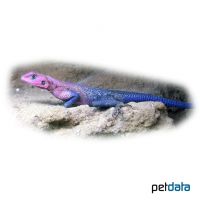Mwanza Flat-headed Rock Agama (Agama mwanzae)
| Mwanza Flat-headed Rock Agama Agama mwanzae | |
|---|---|
| Name | Mwanza Flat-headed Rock Agama |
| Name Lat. | Agama mwanzae |
| Family | Agamas |
| Family lat. | Agamidae |
| Order | Scaled Reptiles |
| Order lat. | Squamata |
| Origin | Africa |
| Habitat | Savanna |
| Diet | Insects, vegetables, fruits |
| Humidity | 40-60 % |
| Behavior | ♂ territorial |
| Keeping | Individual, pair, harem |
| Care Level | Moderate |
| Reproduction | Oviparous |
| Housing | Dry terrarium |
| Life Span | 6-10 years |
| Protection | No |
| Metric Units | |
| Size | 25-40 cm |
| Temperature | 25-35 °C |
| Temperature Local | 45 °C |
| Housing Size | 150 x 90 x 120 cm |
| US Units | |
| Size | 9.8"-16" |
| Temperature | 77-95 °F |
| Temperature Local | 113 °F |
| Housing Size | 60" x 35" x 45" |
Distribution and habitat
The diurnal lilac dragons inhabit the dry steppes and bush savannahs of eastern Africa, from Tanzania and Kenya to Rwanda, where they live in trees and bushes as well as in rock crevices but also on walls of ruins.
Maintenance
Minimum dimensions for the terrarium, according to the size and number of animals
| 1-2 animals | 5KRL x 3KRL x 4KRL (L x W x H) |
Head-torso length (KRL) is measured on the largest animal. For each additional animal, increase the footprint by 15%. A terrarium of e.g. L 150 x W 90 x H 120 cm is recommended, which should be placed in a quiet and vibration-free place
You will need a terrarium structured with roots, climbing branches and stone structures (hiding places and privacy screens, sunning places), a substrate of sand-clay mixture and rubble, a small water container and potted plants (e.g. Aloe, Sanseveria). A small portion of the substrate should be kept moist at all times. Once a day, preferably in the evening, the inside of the terrarium should be finely sprayed with water. 
| Temp. day: 25-35 °C | Temp. night: 18-20 °C | Temp. local: up to 45 °C | Humidity: 40-60 |
The lighting duration must be 12-14 hrs. They need a high light intensity. Light sources that also produce the necessary heat are ideal. In addition, daily UV irradiation is essential.
Diet
The diet consists of insects, such as crickets, grasshoppers, crickets, cockroaches, zophobas and mealybug larvae, alternatively special ready-made food for insectivores can be offered, as well as wild herbs, dandelion flowers, vegetables and some sweet fruit (fruit pulp). Wax moths should only be fed in small amounts to adults, but not to juveniles, because of their large fat content. It is important to add minerals and vitamins regularly (e.g. by dusting the feeders). Young animals should be offered food daily, adult animals 4-5 times a week. Drinking water must always be available
A regular and varied diet promotes health and prevents deficiency symptoms.
Reproduction and breeding
Males are larger and more intensely colored (sexual dimorphism).
The female buries her eggs (5-20 pieces) in the substrate, which must accordingly consist of a substrate suitable for burrowing. The incubation period is 45-80 days at a temperature of 26-30 °C. Small insects such as fruit flies and micro crickets are suitable as initial food for the young animals.
The life expectancy can be 6-10 years.
Important
They are active climbers and good jumpers. Adult males behave very territorial and are incompatible with each other, but also among the females a hierarchy is formed.
With fruit and honey water as food for the feeders, their quality can be upgraded.
The terrarium must have good ventilation without drafts and meet the species specific needs. Measuring devices such as thermometers, hygrometers, etc. are necessary. The lighting has to correspond to the species-specific day-night rhythm and has to be placed in such a way that the animals cannot injure themselves. The terrarium should be locked in such a way that neither unauthorized persons can open it nor the animals can escape. Contamination must be removed regularly
Further literature can be found in your pet store.
References
Text: petdata; Image: petdata
Source: BMELV (1997): Mindestanforderungen an die Haltung von Reptilien; ENGELMANN (2006): Zootierhaltung - Tiere in menschlicher Obhut: Reptilien und Amphibien, Harri Deutsch Verlag
- Gemäß § 21 Abs. 5 Tierschutzgesetz idgF
